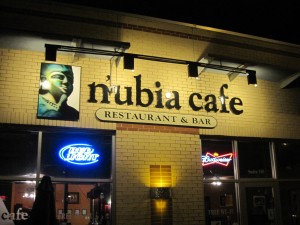 And so tonight after a drought of three months and more, I arrived home, and in heaven, with all but the seventy welcoming virgins, of course. It started as a jest and mild daring that we would drive down to St. Louis to check out the “African” restaurants. I had had a few apples and was just hoping to go to bed but the trip proved a little too tempting to pass, so we – Mafoya the Beninoise, Ben the American and I the traveller hopped in the car and drove to St. Louis, seeking a place called “Nubia Cafe.” The name did not suggest anything other than African so believed that I was going to at least find something to my taste, just like I did in the Indian restaurant in Chicago. At least it was peppery (read spicy) enough to my African tongue.
And so tonight after a drought of three months and more, I arrived home, and in heaven, with all but the seventy welcoming virgins, of course. It started as a jest and mild daring that we would drive down to St. Louis to check out the “African” restaurants. I had had a few apples and was just hoping to go to bed but the trip proved a little too tempting to pass, so we – Mafoya the Beninoise, Ben the American and I the traveller hopped in the car and drove to St. Louis, seeking a place called “Nubia Cafe.” The name did not suggest anything other than African so believed that I was going to at least find something to my taste, just like I did in the Indian restaurant in Chicago. At least it was peppery (read spicy) enough to my African tongue.
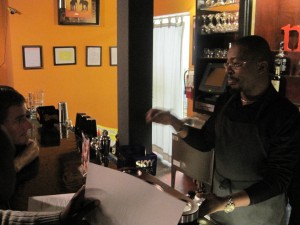
It was the smile of the woman who welcomed us in that gave a first hint. And then the smell from the kitchen, and then the ambiance. Then finally, as we stood staring at the host – a tall and handsome black man with a goatee standing behind the counter, whose smile and sense of mischief led us on a false trail of his true identity – I heard the concluding part of the song Lele by a Nigerian Igbo musical group Resonance seeping in from the surround speakers in the room, and knew at once that I was home. “You’re Nigerian?” I asked, and he nodded, extending his hands. “My name is Henry Iwenofu. Nice to meet you.” And he indeed was a nice personality, well read, smart and articulate.
From then on, things went smoothly, from the overdrive hyperactivity of finally landing on home soil so far away from home to the mellowness of deep conversations that you’d always find among Africans meeting on a distant land.
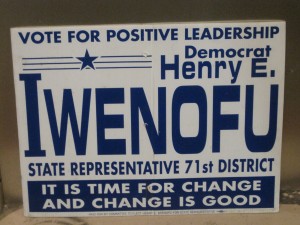 HOW LONG HAVE YOU BEEN HERE?
HOW LONG HAVE YOU BEEN HERE?
“Over twenty-five years”
He should be like forty years himself.
WHEN WERE YOU LAST IN NIGERIA?
“In 1995, briefly.”
I doubt that he remembered much of the June 12 crises, but he has some Youtube videos of the Biafra soldiers’ songs on his phone.
WHERE ARE YOUR PARENTS?
“They were here since a few weeks. They stay with me.”
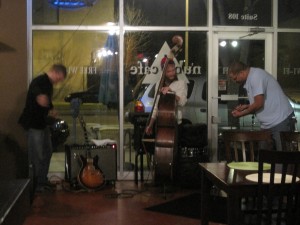 There is a little board sign beside the counter bearing his name. “I contested in the last election for a council seat.” He said. “I didn’t win, but I got some votes.”
There is a little board sign beside the counter bearing his name. “I contested in the last election for a council seat.” He said. “I didn’t win, but I got some votes.”
DO YOU STILL SPEAK IGBO?
“But of course!”
He also happened to speak a bit of Hausa and Yoruba, and he’s an American graduate of a Political Science equivalent course, with a Master in Law. “I’m a barrister” he jokes, “and that’s why I’m now working in a bar.”
HOW LONG HAS NUBIA CAFE BEEN HERE?
“About eighteen months.”
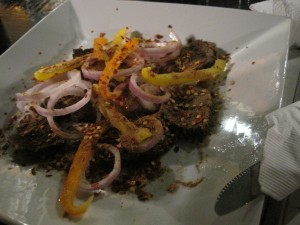 DO YOU SERVE PALM WINE?
DO YOU SERVE PALM WINE?
“We used to do so, but since demand slipped, we have discontinued it as well as Edi-kang-i-kong and Star Lager Beer.”
Still unable to believe my ears, the music changed to Asa’s eponymous album and the songs filtered in one after the other while we enjoyed the meals that came in succession after a few minutes of banter.
Appetizer: Suya/peppersoup (Comments: Very very good, but not the best I’ve had. Ben however loved the soup, even though he had to quickly ask for plenty water so that his tongue/throat doesn’t bleed.)
Main course: Pounded yam and egúsí soup. (Comments: OMG! The Nigerian host even had the audacity to provide forks and knives to eat it with. What? Are you kidding?)
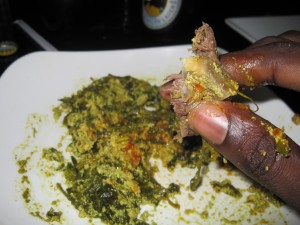 Drinks: Tusker beer from Kenya (Comments: none)
Drinks: Tusker beer from Kenya (Comments: none)
After the meal, which was accompanied later by a live band in the corner of the room, we got down to the real African past-time: arguing. It took the whole hour and even though we agreed on little, we shared much, and Ben just looked on, sometimes bored, and sometimes animated. It was his first time in an African restaurant, and it could as well have been his first time seeing two Africans argue, on such an unimportant topic as whether or not we were different, or the same even though we come from different places… This argument must have arisen from a question as to whether he would be going back home. No, he says, but not for reasons I expected (political instability, poverty etc), but because, according to him, “I don’t have the money. I can’t afford to make such trips regularly.”
 The other woman who had welcomed us in with a smile turned out to be from Tennessee, and she found the whole show we had put up to be very amusing. She was going to find it a lot more amusing when, as it was time for us to pay and head back to Edwardsville, I looked at the bill and had a very bright idea. Since I’ve been in the US, I’ve been gradually initiated into the tipping culture and found a certain joy in leaving little change for the people who had made effort (don’t tell me it’s their job) to provide good quality service. So to show my appreciation tonight, I looked into my purse and brought out the crispiest – well, not necessarily the crispiest – of my Nigerian currency notes. It was a two hundred. I had brought the Nigerian currency notes along to the States only to show my students (and some of them have actually “won” a few of them for keeps while answering questions in class), and for other unexplainable reasons, but as I looked at the space for tips on the bill, I could think of nothing more appropriate to give back to this long range traveller like me than a small piece of home.
The other woman who had welcomed us in with a smile turned out to be from Tennessee, and she found the whole show we had put up to be very amusing. She was going to find it a lot more amusing when, as it was time for us to pay and head back to Edwardsville, I looked at the bill and had a very bright idea. Since I’ve been in the US, I’ve been gradually initiated into the tipping culture and found a certain joy in leaving little change for the people who had made effort (don’t tell me it’s their job) to provide good quality service. So to show my appreciation tonight, I looked into my purse and brought out the crispiest – well, not necessarily the crispiest – of my Nigerian currency notes. It was a two hundred. I had brought the Nigerian currency notes along to the States only to show my students (and some of them have actually “won” a few of them for keeps while answering questions in class), and for other unexplainable reasons, but as I looked at the space for tips on the bill, I could think of nothing more appropriate to give back to this long range traveller like me than a small piece of home.
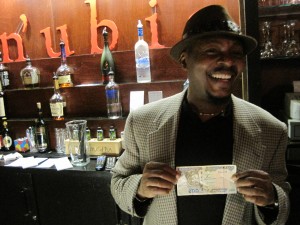
In American currency, it is less than $2, but from one traveller to another – albeit one more temporarily resident than him – I was handing him a touch from his distant past.
“I’ll frame this,” he said, as he posed for a photograph, and the Tennessee woman who sat beside him kept grinning from ear to ear, looking at me with a mixture of thrill and quirky interest. She definitely didn’t see this one coming, and much as she tried to find out from me how much the note was worth in American currency, she failed, to my delight. It was my first experience of home away from home. And from this heaviness of my tummy now as I return from the eating and all the merrying, I feel the warmth of home. Hello Nigeria.
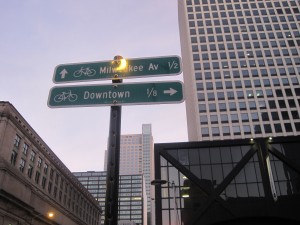

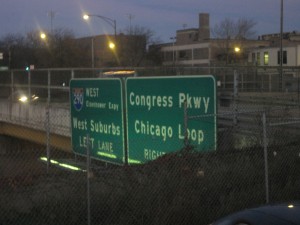
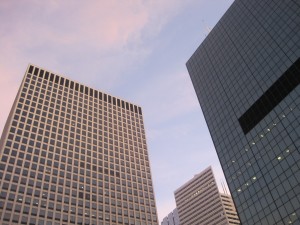
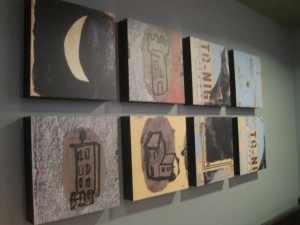
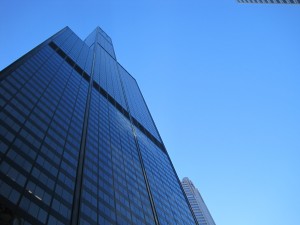
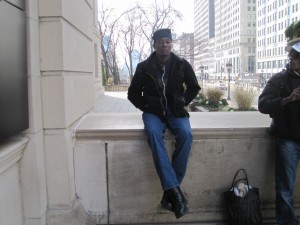
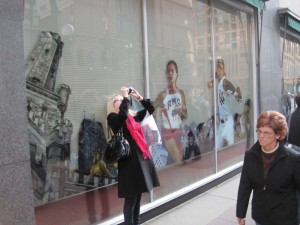
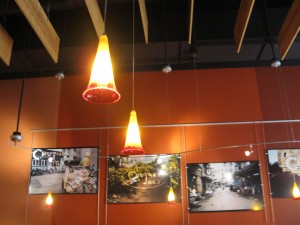

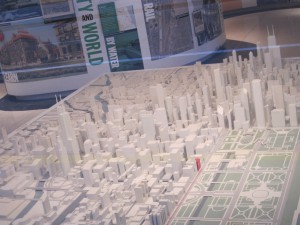
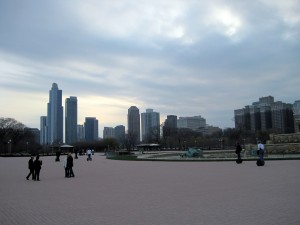
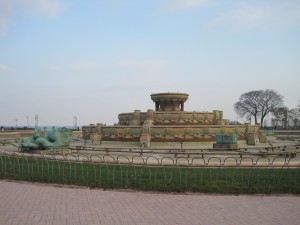
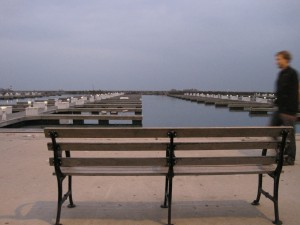
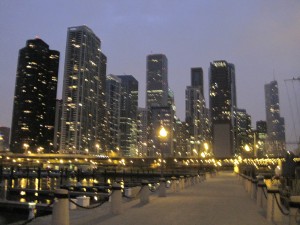
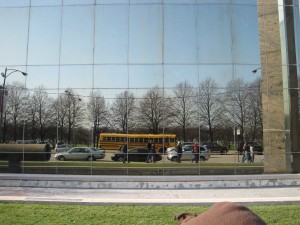

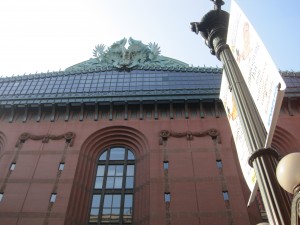
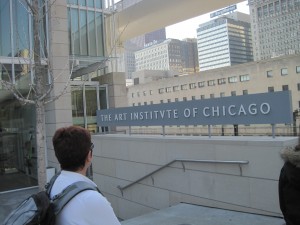
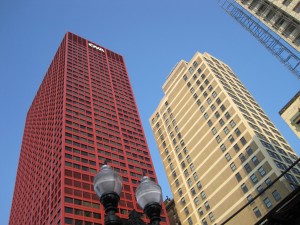
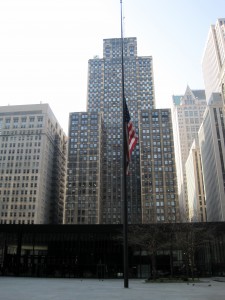
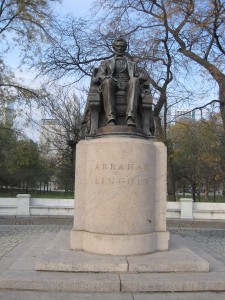 Since I spent much of my time in Chicago last week either taking pictures or admiring the landscape and its contrasting colours, it is only fitting that I make a third, and maybe final post on what I saw while I was there. On the first night alone, I had already taken a few hundred photos of everything beautiful from road signs, shop signs, name tags to sign posts and street names. By the end of the weekend, there were already too many to choose from. Anyway, here are some of the rest, featuring the Willis Tower, a toy model of the city, the Navy Pier, Artworks on teh wall at Starbucks, the Fisher Building, the Buckingham fountain, the city at night, and a statue of President Lincoln at Grant Park. I hope you like them.
Since I spent much of my time in Chicago last week either taking pictures or admiring the landscape and its contrasting colours, it is only fitting that I make a third, and maybe final post on what I saw while I was there. On the first night alone, I had already taken a few hundred photos of everything beautiful from road signs, shop signs, name tags to sign posts and street names. By the end of the weekend, there were already too many to choose from. Anyway, here are some of the rest, featuring the Willis Tower, a toy model of the city, the Navy Pier, Artworks on teh wall at Starbucks, the Fisher Building, the Buckingham fountain, the city at night, and a statue of President Lincoln at Grant Park. I hope you like them.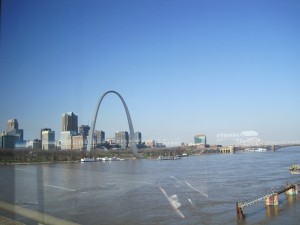
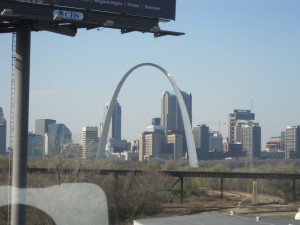
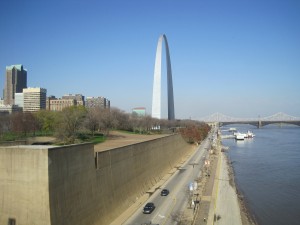
 A little after we left Cahokia on Saturday, we headed to the St. Louis to visit the state of Missouri’s most famous landmark – the St. Louis Gateway Arch, also called the “Gateway to the West” because of its place in history as the spot where the first expedition to the Western part of the United States began. It is an integral part of the
A little after we left Cahokia on Saturday, we headed to the St. Louis to visit the state of Missouri’s most famous landmark – the St. Louis Gateway Arch, also called the “Gateway to the West” because of its place in history as the spot where the first expedition to the Western part of the United States began. It is an integral part of the 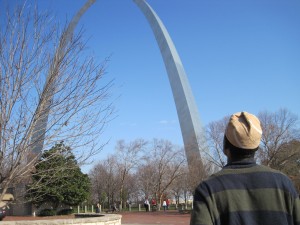
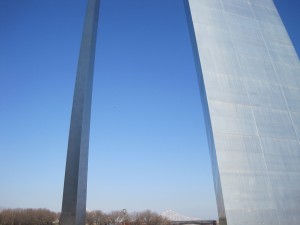
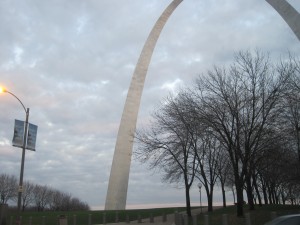
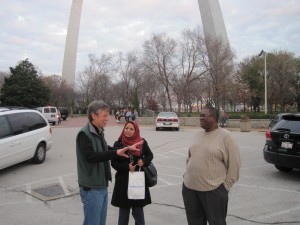 The St. Louis Arch is located along the Mississippi river and close to the road bridges that connect the states of Illinois and Missouri. It is called the Gateway to the West because of the role it played when officers
The St. Louis Arch is located along the Mississippi river and close to the road bridges that connect the states of Illinois and Missouri. It is called the Gateway to the West because of the role it played when officers 

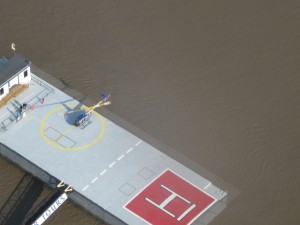
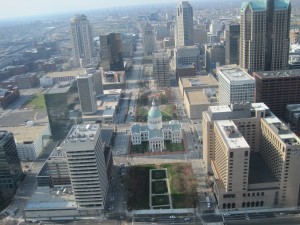 At the top, we got off and walked up the flight of a few steps into the observatory itself where we were able to look down out of a series of windows. Even though it didn’t shake with the wind that must have been blowing outside, and even though there had never been a terrorist or vandalism attack on the monument that could have given me given me fright of death or falling, I felt a little afraid looking into the river from over six hundred feet above the earth. What if? There was a helicopter landing pad nearby where one landed and shortly took off. From afar, I could see that it was a tourist helicopter – for hire – and not a police one, so I wasn’t immediately relieved from my anxiety. If anything had happened while we were up there, I’d probably be long dead before landing on the pavement below, except I was lucky to have been blown by a strong wind right into the Mississippi river.
At the top, we got off and walked up the flight of a few steps into the observatory itself where we were able to look down out of a series of windows. Even though it didn’t shake with the wind that must have been blowing outside, and even though there had never been a terrorist or vandalism attack on the monument that could have given me given me fright of death or falling, I felt a little afraid looking into the river from over six hundred feet above the earth. What if? There was a helicopter landing pad nearby where one landed and shortly took off. From afar, I could see that it was a tourist helicopter – for hire – and not a police one, so I wasn’t immediately relieved from my anxiety. If anything had happened while we were up there, I’d probably be long dead before landing on the pavement below, except I was lucky to have been blown by a strong wind right into the Mississippi river.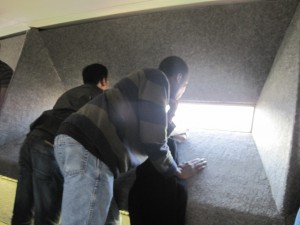
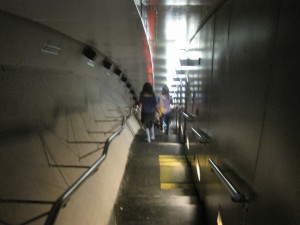
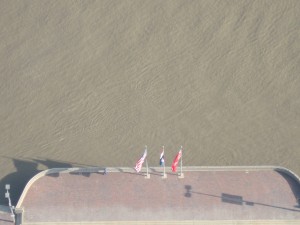
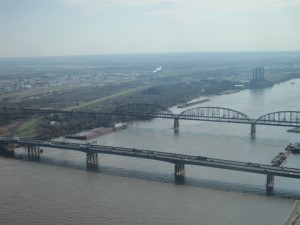
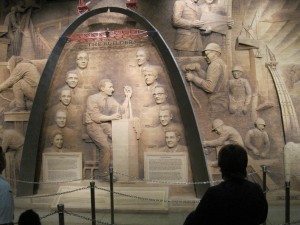
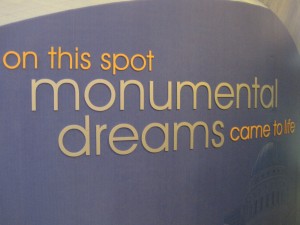 But we were lucky, Reham and I. There were no attacks, and the uniformed officers on the observation deck with us didn’t have any work to do while we were up there than to pace up and down observing everyone as they did so. When we got enough of our shots up there, we went back down the same way we came, this time faster. It is always easier coming down in an elevator than going up. We then went around the gift shop, and later into the theatre within the complex, to see a documentary movie about the expedition of Louis and Clark, also eponymously titled, before going into the museum where we saw even more of the Native-American history. The famous expedition of officers
But we were lucky, Reham and I. There were no attacks, and the uniformed officers on the observation deck with us didn’t have any work to do while we were up there than to pace up and down observing everyone as they did so. When we got enough of our shots up there, we went back down the same way we came, this time faster. It is always easier coming down in an elevator than going up. We then went around the gift shop, and later into the theatre within the complex, to see a documentary movie about the expedition of Louis and Clark, also eponymously titled, before going into the museum where we saw even more of the Native-American history. The famous expedition of officers 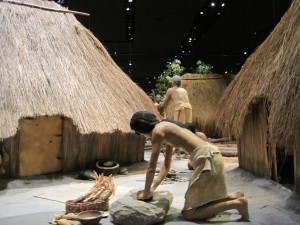
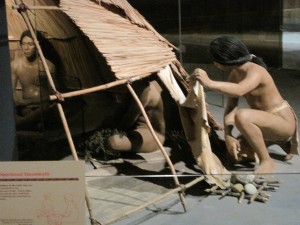
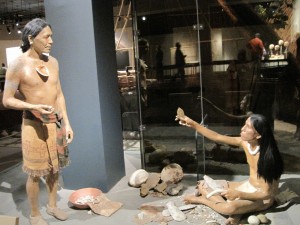
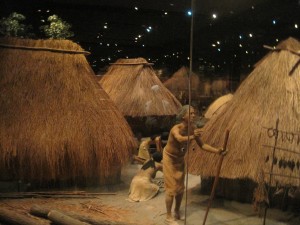 Occupying over 2,200 acres of land space near Collinsville, Illinois, is an old Native-American settlement called Cahokia. It was so named after a tribe of indigenous and ingenuous native people who occupied the spot thousands of years ago and built a city that was at a time bigger than the city of London. Today, due to a reason not yet fully discovered and reconstructed, the city of
Occupying over 2,200 acres of land space near Collinsville, Illinois, is an old Native-American settlement called Cahokia. It was so named after a tribe of indigenous and ingenuous native people who occupied the spot thousands of years ago and built a city that was at a time bigger than the city of London. Today, due to a reason not yet fully discovered and reconstructed, the city of 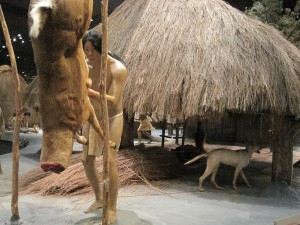
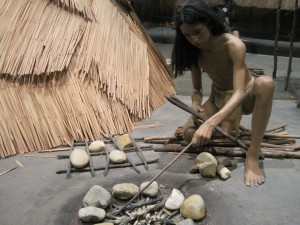
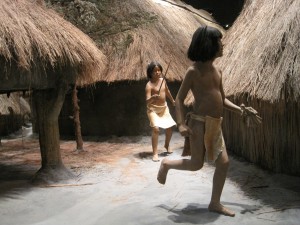
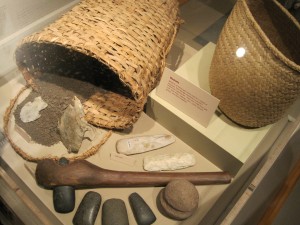 The site is basically an expanse of land with many mounds – or let’s say man-made hills. Excavations done there over the years have produced evidence that archeologists have used to learn all they now know about the place, their tools, their clothings, their burial practices and their system of government.
The site is basically an expanse of land with many mounds – or let’s say man-made hills. Excavations done there over the years have produced evidence that archeologists have used to learn all they now know about the place, their tools, their clothings, their burial practices and their system of government. Another most thrilling discovery I made was this: a spinning toy belonging to old Cahokia which was made of a little round wheel and a short thread that runs through it. It worked like this: with a little spin by one of the two hands that hold the thread on each side, the wheel rolled on for a while, and when the user pulled the thread apart, the wheel spins by itself clockwise, anti-clockwise, and then clockwise again in perpetuity as long as the user kept pulling the thread apart in either directions. Those who grew up in rural, or at least fun and playful neighbourhoods, in Western Nigeria would remember the same replica which was fashioned with the cap of soda bottles made flat and punctured with two holes. Check out the picture to the right and tell me if you see a difference. Holding it in my hand today brought back a cold thrill of an almost forgotten past. And yet, here I was Cahokia, and not in Akobò.
Another most thrilling discovery I made was this: a spinning toy belonging to old Cahokia which was made of a little round wheel and a short thread that runs through it. It worked like this: with a little spin by one of the two hands that hold the thread on each side, the wheel rolled on for a while, and when the user pulled the thread apart, the wheel spins by itself clockwise, anti-clockwise, and then clockwise again in perpetuity as long as the user kept pulling the thread apart in either directions. Those who grew up in rural, or at least fun and playful neighbourhoods, in Western Nigeria would remember the same replica which was fashioned with the cap of soda bottles made flat and punctured with two holes. Check out the picture to the right and tell me if you see a difference. Holding it in my hand today brought back a cold thrill of an almost forgotten past. And yet, here I was Cahokia, and not in Akobò. And so tonight after a drought of three months and more, I arrived home, and in heaven, with all but the seventy welcoming virgins, of course. It started as a jest and mild daring that we would drive down to St. Louis to check out the “African” restaurants. I had had a few apples and was just hoping to go to bed but the trip proved a little too tempting to pass, so we – Mafoya the Beninoise, Ben the American and I the traveller hopped in the car and drove to St. Louis, seeking a place called “Nubia Cafe.” The name did not suggest anything other than African so believed that I was going to at least find something to my taste, just like I did in the Indian restaurant in Chicago. At least it was peppery (read spicy) enough to my African tongue.
And so tonight after a drought of three months and more, I arrived home, and in heaven, with all but the seventy welcoming virgins, of course. It started as a jest and mild daring that we would drive down to St. Louis to check out the “African” restaurants. I had had a few apples and was just hoping to go to bed but the trip proved a little too tempting to pass, so we – Mafoya the Beninoise, Ben the American and I the traveller hopped in the car and drove to St. Louis, seeking a place called “Nubia Cafe.” The name did not suggest anything other than African so believed that I was going to at least find something to my taste, just like I did in the Indian restaurant in Chicago. At least it was peppery (read spicy) enough to my African tongue.
 HOW LONG HAVE YOU BEEN HERE?
HOW LONG HAVE YOU BEEN HERE? There is a little board sign beside the counter bearing his name. “I contested in the last election for a council seat.” He said. “I didn’t win, but I got some votes.”
There is a little board sign beside the counter bearing his name. “I contested in the last election for a council seat.” He said. “I didn’t win, but I got some votes.” DO YOU SERVE PALM WINE?
DO YOU SERVE PALM WINE? Drinks: Tusker beer from Kenya (Comments: none)
Drinks: Tusker beer from Kenya (Comments: none) The other woman who had welcomed us in with a smile turned out to be from Tennessee, and she found the whole show we had put up to be very amusing. She was going to find it a lot more amusing when, as it was time for us to pay and head back to Edwardsville, I looked at the bill and had a very bright idea. Since I’ve been in the US, I’ve been gradually initiated into the tipping culture and found a certain joy in leaving little change for the people who had made effort (don’t tell me it’s their job) to provide good quality service. So to show my appreciation tonight, I looked into my purse and brought out the crispiest – well, not necessarily the crispiest – of my Nigerian currency notes. It was a two hundred. I had brought the Nigerian currency notes along to the States only to show my students (and some of them have actually “won” a few of them for keeps while answering questions in class), and for other unexplainable reasons, but as I looked at the space for tips on the bill, I could think of nothing more appropriate to give back to this long range traveller like me than a small piece of home.
The other woman who had welcomed us in with a smile turned out to be from Tennessee, and she found the whole show we had put up to be very amusing. She was going to find it a lot more amusing when, as it was time for us to pay and head back to Edwardsville, I looked at the bill and had a very bright idea. Since I’ve been in the US, I’ve been gradually initiated into the tipping culture and found a certain joy in leaving little change for the people who had made effort (don’t tell me it’s their job) to provide good quality service. So to show my appreciation tonight, I looked into my purse and brought out the crispiest – well, not necessarily the crispiest – of my Nigerian currency notes. It was a two hundred. I had brought the Nigerian currency notes along to the States only to show my students (and some of them have actually “won” a few of them for keeps while answering questions in class), and for other unexplainable reasons, but as I looked at the space for tips on the bill, I could think of nothing more appropriate to give back to this long range traveller like me than a small piece of home.